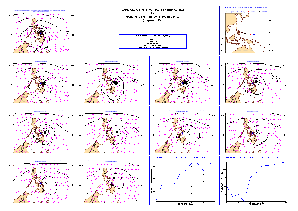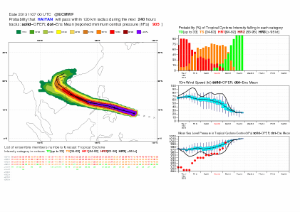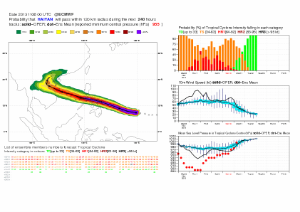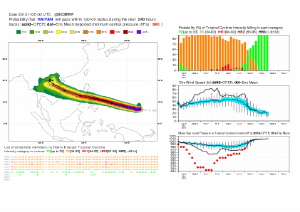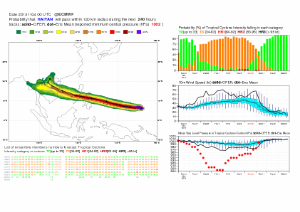Status: Finalized Material from: Linus
Discussed in the following Daily reports:
http://intra.ecmwf.int/daily/d/dreport/2013/11/05/sc/
http://intra.ecmwf.int/daily/d/dreport/2013/11/06/sc/
http://intra.ecmwf.int/daily/d/dreport/2013/11/07/sc/
1. Impact
On the 7 November 2013 super-typhoon Haiyan made landfall on the Philippines. During the landfall on the Philippines more than 6000 people were killed. Super-typhoon Haiyan was the third category 5 typhoon to hit the Philippines since 2010.
In 2010, Megi made landfall and resulted in 35 people dead and in 2012 Bupha resulted in 1901 dead. The tropical storm seasons in the north-western Pacific is one of the most active and Haiyan was cyclone number 3? and the fifth to made landfall on the Philippines (together with Rumbia, Nari, Utor and Krosa). After making landfall on the Philippines, the cyclone made landfall on the 11 November in southern China and Vietnam.
The worst effect was caused by the storm surge in connection to the cyclone on the Leyte and Samar islands.
See Wikipedia for a longer description of the impact. http://en.wikipedia.org/wiki/Haiyan#Philippines_2
2. Description of the event
The cyclone formed on the 3 November. On the 6 November 00 UTC the cyclone first classified as a super-typhoon. Late on the 7 November the cyclone made landfall on southern Philippines. Just before (18 UTC) the wind speed was (estimated?) 195 mph.
MODIS satellite image of Super Typhoon Haiyan taken at 4:25 UTC November 7, 2013. At the time, Haiyan was a Category 5 storm with top winds of 175 mph. The Philippines are visible at the left of the image, and the Caroline Islands at the lower right. Image credit: NASA. Copied from http://www.wunderground.com/blog/JeffMasters/comment.html?entrynum=2572
3. Predictability
3.1 Data assimilation
The figure above shows forecasts of the minimum pressure from long-window 4dvar forecasts, initialised every 12 hour (6 and 18 UTC). In black the estimated (for the hurricane centre at JMA) minimum pressure is plotted. The 12-hour forecast is used as first guess for the next analysis. Especially for the analysis of 7 Nov 18 UTC, the minimum pressure in the analysis is much higher than in the first guess, although the estimate is much lower. The problem here could be that the increments in the data-assimilation is much more large scale that this feature.
This figure shows the same as the previous one but for the e-suite. One difference in the e-suite is the flow-dependent length scale of increments. However, for this case we do not see any big impact of the change.
The figures above shows the MSLP of the first guess and analysis for 7 Nov 18 UTC. This confirms that the cyclone is much more shallow in the analysis.
3.2 HRES
The figure above shows verification of the MSLP fields valid 8 Nov 00 UTC. For high-resolution ps-file, click here. Already the HRES forecast from 10 days before had a cyclone in vicinity of the Philippines. In the forecast from the 3 and 4 November the cyclone starts to be more intense. However, the minimum pressure error is very large (60-70 hPa).
3.3 ENS
The figures above shows the strike probability product from 8, 7, 6, 5 and 4 November 00 UTC. Here we see a very consistent ensemble regarding the track, but the ensemble has even higher minimum pressure than the HRES.
3.4 Monthly forecasts
Strike probability of a tropical storm for the period 4 to 10 November. forecasts from 4 Nov, 31 Oct, 28 Oct, 24 Oct and 21 October. As expected for above the forecast from 4 November had a high strike probability. For the earlier forecasts there is a risk for a cyclone. However, when checking the climatological occurrences (see figure below), we see that the probabilities are not different from the climatology.
3.5 Comparison with other centres
Control forecasts (from TIGGE) from ECMWF, UKMO, NCEP and JMA. The plots above show MSLP for forecasts initialised 6 Nov 12 UTC and valid 8 Nov 00 UTC.
Control forecasts (from TIGGE) from ECMWF, UKMO, NCEP and JMA. The plots above show MSLP for forecasts initialised 5 Nov 12 UTC and valid 8 Nov 00 UTC.
4. Experience from general performance/other cases
- Megi, Bopha: super-typhoons with far too high minimum pressure
The figures above shows the MSLP forecast for Haiyan (4 day forecast valid 7 Nov 12 UTC), Megi with T1279 (5 day forecast) and Megi with T3999 (also 5 day forecast). All three figures have a 5x5 degree box. For Megi, the observed minimum pressure was 911 hPa. For T1279 it was 990 hPa and T3999 920 Pa. The figure below shows time-series of the minimum pressure for Megi for these two runs (T1279 -red, T3999 - blue) ) and the operational forecast 12 hours before the landfall (green), together with the Best Track estimate (black). The cyclone made landfall on the Philippines 19 October 2010. We clearly see that the minimum pressure improves with resolution. After passing the Philippines the cyclone deepened in the two forecasts from the 13 October, which is a clear forecast error (probably of random nature).
However, we need to do T3999 simulations also for weak tropical cyclones to verify that we not have a negative pressure bias.
The figures above shows MSLP for the operational T1279 (left) and T2047 (expid:g053, right) for 48h forecasts valid 8 November 00 UTC in a 5x5 degree box. The minimum pressure in T1279 is 943 hPa and in T2047 922 hPa.
The figures above shows MSLP for the operational T1279 (left) and T2047 (expid:g053, right) for 72h forecasts valid 8 November 00 UTC in a 5x5 degree box. The minimum pressure in T1279 is 953 hPa and in T2047 932 hPa.
The figures above shows the 48-hour forecasts for the two resolutions of MSLP (contour) and 850 hPa vorticity. The plotting box is 1.5x1.5 degrees. For the T2047 run (right), it looks like the eye wall is starting to be resolved, which is not the case for T1279. - Francesco: Why did the model produce such a low pressure for Francesco and not for Haiyan?
The figures above shows examples of MSLP of Francesco (left) and Haiyan (right), 36 hours into the forecast. Here we see that Francesco was a much more large-scale system, so the pressure gradients look similar even if Francesco had a minimum pressure of 911 hPa and Haiyan 944 hPa.
5. Good and bad aspects of the forecasts for the event
- Good and consistent forecasts of the track
- Far to high minimum pressure
- Data assimilation made the cyclone less intense?
6. Additional material
From the WGNE Intercomparison of Tropical Cyclone Track Forecasts, I (Linus) found the following diagnostics of tropical cyclone minimum pressure. The figures below shows scatter plots of observed vs. modelled pressure for the north-western Pactific for the season of 2010. The plots are for ECMWF, UKMO, NCEP and JMA.
For this period, ECMWF seems to have the strongest relation between the observed and modelled depth. The deepest observed typhoon here was Megi with a minimum pressure of less than 900 hPa.For the other centres, NCEP and UKMO have the worst underestimation of the pressure.





